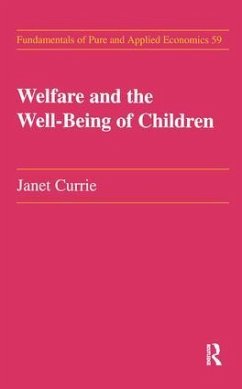Janet M Currie
Welfare and the Well-Being of Children
Janet M Currie
Welfare and the Well-Being of Children
- Gebundenes Buch
- Merkliste
- Auf die Merkliste
- Bewerten Bewerten
- Teilen
- Produkt teilen
- Produkterinnerung
- Produkterinnerung
An analysis of eight of the largest US welfare programmes affecting children. Programmes discussed include: Medicaid, Aid to Families with Dependent Children, the Food Stamp Program, WIC and School Lunch, Head Start and the Earned Income Tax Credit.
Andere Kunden interessierten sich auch für
![Cultural Politics of the Creative Industries Cultural Politics of the Creative Industries]() Phil GrahamCultural Politics of the Creative Industries195,99 €
Phil GrahamCultural Politics of the Creative Industries195,99 €![Storytelling Across Worlds Storytelling Across Worlds]() Tom DowdStorytelling Across Worlds196,99 €
Tom DowdStorytelling Across Worlds196,99 €![Travel, Tourism and the Moving Image Travel, Tourism and the Moving Image]() Sue BeetonTravel, Tourism and the Moving Image160,99 €
Sue BeetonTravel, Tourism and the Moving Image160,99 €![Cultural Representations of Feminicidio at the Us-Mexico Border Cultural Representations of Feminicidio at the Us-Mexico Border]() Nuala FinneganCultural Representations of Feminicidio at the Us-Mexico Border197,99 €
Nuala FinneganCultural Representations of Feminicidio at the Us-Mexico Border197,99 €![Producing for Profit Producing for Profit]() Andrew StevensProducing for Profit166,99 €
Andrew StevensProducing for Profit166,99 €![Red Carpet Red Carpet]() Erich SchwartzelRed Carpet19,99 €
Erich SchwartzelRed Carpet19,99 €![Albert Okura the Chicken Man Albert Okura the Chicken Man]() Albert OkuraAlbert Okura the Chicken Man31,99 €
Albert OkuraAlbert Okura the Chicken Man31,99 €-
-
-
An analysis of eight of the largest US welfare programmes affecting children. Programmes discussed include: Medicaid, Aid to Families with Dependent Children, the Food Stamp Program, WIC and School Lunch, Head Start and the Earned Income Tax Credit.
Hinweis: Dieser Artikel kann nur an eine deutsche Lieferadresse ausgeliefert werden.
Hinweis: Dieser Artikel kann nur an eine deutsche Lieferadresse ausgeliefert werden.
Produktdetails
- Produktdetails
- Verlag: Taylor & Francis
- Seitenzahl: 184
- Erscheinungstermin: 7. Februar 2017
- Englisch
- Abmessung: 216mm x 140mm x 13mm
- Gewicht: 367g
- ISBN-13: 9781138165762
- ISBN-10: 113816576X
- Artikelnr.: 69946408
- Herstellerkennzeichnung
- Libri GmbH
- Europaallee 1
- 36244 Bad Hersfeld
- gpsr@libri.de
- Verlag: Taylor & Francis
- Seitenzahl: 184
- Erscheinungstermin: 7. Februar 2017
- Englisch
- Abmessung: 216mm x 140mm x 13mm
- Gewicht: 367g
- ISBN-13: 9781138165762
- ISBN-10: 113816576X
- Artikelnr.: 69946408
- Herstellerkennzeichnung
- Libri GmbH
- Europaallee 1
- 36244 Bad Hersfeld
- gpsr@libri.de
Janet M. Currie University of California, Los Angeles, USA, Finis Welch Texas A&M University, Texas, USA
Introduction Part 1: An Overview of Methods, Measures, and Programs 1.
Methods for Evaluating Welfare Programs A: Experiments B: Instrumental
Variables, "Natural Experiments", and Selection Corrections C: Fixed
Effects and Random Effects Models D: Summary 2. Measures of Child
Well-Being 1A. Measures of Health Status B: Test Scores and Scholastic
Achievement C: Long-Run Measures of Social Competence 3D: Other Measures 3.
The Programs A: An Overview of Spending on Programs that Benefit Children
B: Trends in Caseloads and Expenditures C: Do Welfare Programs Raise
Children Out of Poverty? D: Spending on Children Compared to Spending on
the Elderly E: Summary Part 2: Evaluation of Individual Programs 4. AFDC A:
Effects of AFDC on Young Children B: Intergenerational Transmission of
Poverty and Welfare Dependency C: AFDC Effects on Teen Pregnancy and Child
Bearing D: Summary 5. Medicaid A: Insurance Coverage and the Utilization of
Care B: The Link Between Utilization of Medical Care and Child Health C:
Summary 6. The Food Stamp Program A: Effects on Nutrition B: Effects on
Food Expenditures C: Summary 7. WIC and School Nutrition Programs A: WIC B:
School Nutrition Programs C: Other Child Nutrition Programs D: Summary 8.
Head Start A: Short-Term Effects of Head Start B: Longer-Term Effects of
Head Start C: Discussion D: Summary 9. Housing Assistance A: Adequate
Housing for All? B: The Effects of Neighborhoods C: The Role of Housing
Assistance Programs: The Construction of Public Housing Vs. Vouchers D:
Summary 10. The Earned Income Tax Credit A: Parallels Between the EITC and
the NIT B: Effects of the NIT C: Summary
Methods for Evaluating Welfare Programs A: Experiments B: Instrumental
Variables, "Natural Experiments", and Selection Corrections C: Fixed
Effects and Random Effects Models D: Summary 2. Measures of Child
Well-Being 1A. Measures of Health Status B: Test Scores and Scholastic
Achievement C: Long-Run Measures of Social Competence 3D: Other Measures 3.
The Programs A: An Overview of Spending on Programs that Benefit Children
B: Trends in Caseloads and Expenditures C: Do Welfare Programs Raise
Children Out of Poverty? D: Spending on Children Compared to Spending on
the Elderly E: Summary Part 2: Evaluation of Individual Programs 4. AFDC A:
Effects of AFDC on Young Children B: Intergenerational Transmission of
Poverty and Welfare Dependency C: AFDC Effects on Teen Pregnancy and Child
Bearing D: Summary 5. Medicaid A: Insurance Coverage and the Utilization of
Care B: The Link Between Utilization of Medical Care and Child Health C:
Summary 6. The Food Stamp Program A: Effects on Nutrition B: Effects on
Food Expenditures C: Summary 7. WIC and School Nutrition Programs A: WIC B:
School Nutrition Programs C: Other Child Nutrition Programs D: Summary 8.
Head Start A: Short-Term Effects of Head Start B: Longer-Term Effects of
Head Start C: Discussion D: Summary 9. Housing Assistance A: Adequate
Housing for All? B: The Effects of Neighborhoods C: The Role of Housing
Assistance Programs: The Construction of Public Housing Vs. Vouchers D:
Summary 10. The Earned Income Tax Credit A: Parallels Between the EITC and
the NIT B: Effects of the NIT C: Summary
Introduction Part 1: An Overview of Methods, Measures, and Programs 1.
Methods for Evaluating Welfare Programs A: Experiments B: Instrumental
Variables, "Natural Experiments", and Selection Corrections C: Fixed
Effects and Random Effects Models D: Summary 2. Measures of Child
Well-Being 1A. Measures of Health Status B: Test Scores and Scholastic
Achievement C: Long-Run Measures of Social Competence 3D: Other Measures 3.
The Programs A: An Overview of Spending on Programs that Benefit Children
B: Trends in Caseloads and Expenditures C: Do Welfare Programs Raise
Children Out of Poverty? D: Spending on Children Compared to Spending on
the Elderly E: Summary Part 2: Evaluation of Individual Programs 4. AFDC A:
Effects of AFDC on Young Children B: Intergenerational Transmission of
Poverty and Welfare Dependency C: AFDC Effects on Teen Pregnancy and Child
Bearing D: Summary 5. Medicaid A: Insurance Coverage and the Utilization of
Care B: The Link Between Utilization of Medical Care and Child Health C:
Summary 6. The Food Stamp Program A: Effects on Nutrition B: Effects on
Food Expenditures C: Summary 7. WIC and School Nutrition Programs A: WIC B:
School Nutrition Programs C: Other Child Nutrition Programs D: Summary 8.
Head Start A: Short-Term Effects of Head Start B: Longer-Term Effects of
Head Start C: Discussion D: Summary 9. Housing Assistance A: Adequate
Housing for All? B: The Effects of Neighborhoods C: The Role of Housing
Assistance Programs: The Construction of Public Housing Vs. Vouchers D:
Summary 10. The Earned Income Tax Credit A: Parallels Between the EITC and
the NIT B: Effects of the NIT C: Summary
Methods for Evaluating Welfare Programs A: Experiments B: Instrumental
Variables, "Natural Experiments", and Selection Corrections C: Fixed
Effects and Random Effects Models D: Summary 2. Measures of Child
Well-Being 1A. Measures of Health Status B: Test Scores and Scholastic
Achievement C: Long-Run Measures of Social Competence 3D: Other Measures 3.
The Programs A: An Overview of Spending on Programs that Benefit Children
B: Trends in Caseloads and Expenditures C: Do Welfare Programs Raise
Children Out of Poverty? D: Spending on Children Compared to Spending on
the Elderly E: Summary Part 2: Evaluation of Individual Programs 4. AFDC A:
Effects of AFDC on Young Children B: Intergenerational Transmission of
Poverty and Welfare Dependency C: AFDC Effects on Teen Pregnancy and Child
Bearing D: Summary 5. Medicaid A: Insurance Coverage and the Utilization of
Care B: The Link Between Utilization of Medical Care and Child Health C:
Summary 6. The Food Stamp Program A: Effects on Nutrition B: Effects on
Food Expenditures C: Summary 7. WIC and School Nutrition Programs A: WIC B:
School Nutrition Programs C: Other Child Nutrition Programs D: Summary 8.
Head Start A: Short-Term Effects of Head Start B: Longer-Term Effects of
Head Start C: Discussion D: Summary 9. Housing Assistance A: Adequate
Housing for All? B: The Effects of Neighborhoods C: The Role of Housing
Assistance Programs: The Construction of Public Housing Vs. Vouchers D:
Summary 10. The Earned Income Tax Credit A: Parallels Between the EITC and
the NIT B: Effects of the NIT C: Summary








